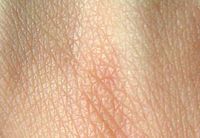
Photo from wikipedia
Induced pluripotent stem cells (iPSC) are a promising tool for personalized cell therapy, in particular, in the field of dermatology. Metabolic plasticity of iPSC are not completely understood due to… Click to show full abstract
Induced pluripotent stem cells (iPSC) are a promising tool for personalized cell therapy, in particular, in the field of dermatology. Metabolic plasticity of iPSC are not completely understood due to the fact that iPSC have a mixed mitochondrial phenotype, which still resembles that of somatic cells. In this study we investigated the metabolic changes in iPSC undergoing differentiation in two directions, dermal and epidermal, using two-photon fluorescence microscopy combined with FLIM. Directed differentiation of iPSC into dermal fibroblasts and keratinocyte progenitor cells was induced. Cellular metabolism was examined on the basis of the fluorescence of the metabolic cofactors NAD(P)H and FAD. The optical redox ratio (FAD/NAD(P)H) and the fluorescence lifetimes of NAD(P)H and FAD were traced using two-photon fluorescence microscopy combined with FLIM. Evaluation of the intracellular pH was carried out with the fluorescent рН sensor SypHer-2 and fluorescence microscopy. In this study, evaluation of the metabolic status of iPSC during dermal and epidermal differentiation was accomplished for the first time with the use of optical metabolic imaging. Based on the data on the FAD/NAD(P)H redox ratio and on the fluorescence lifetimes of protein-bound form of NAD(P)H and closed form of FAD, we registered a metabolic shift toward a more oxidative status in the process of iPSC differentiation into dermal fibroblasts and keratinocyte progenitor cells. Biosynthetic processes occurring in dermal fibroblasts associated with the synthesis of fibronectin and versican, that stimulate increased energy metabolism and lower the intracellular pH. No intracellular pH shift is observed in the culture of keratinocyte progenitor cells, which reflects the incomplete process of differentiation in this type of cells. Presented results provide the basis for further understanding the metabolic features of iPSC during differentiation process, which is essential for developing new treatment strategies in cell therapy and tissue engineering. .
Journal Title: Methods and applications in fluorescence
Year Published: 2019
Link to full text (if available)
Share on Social Media: Sign Up to like & get
recommendations!